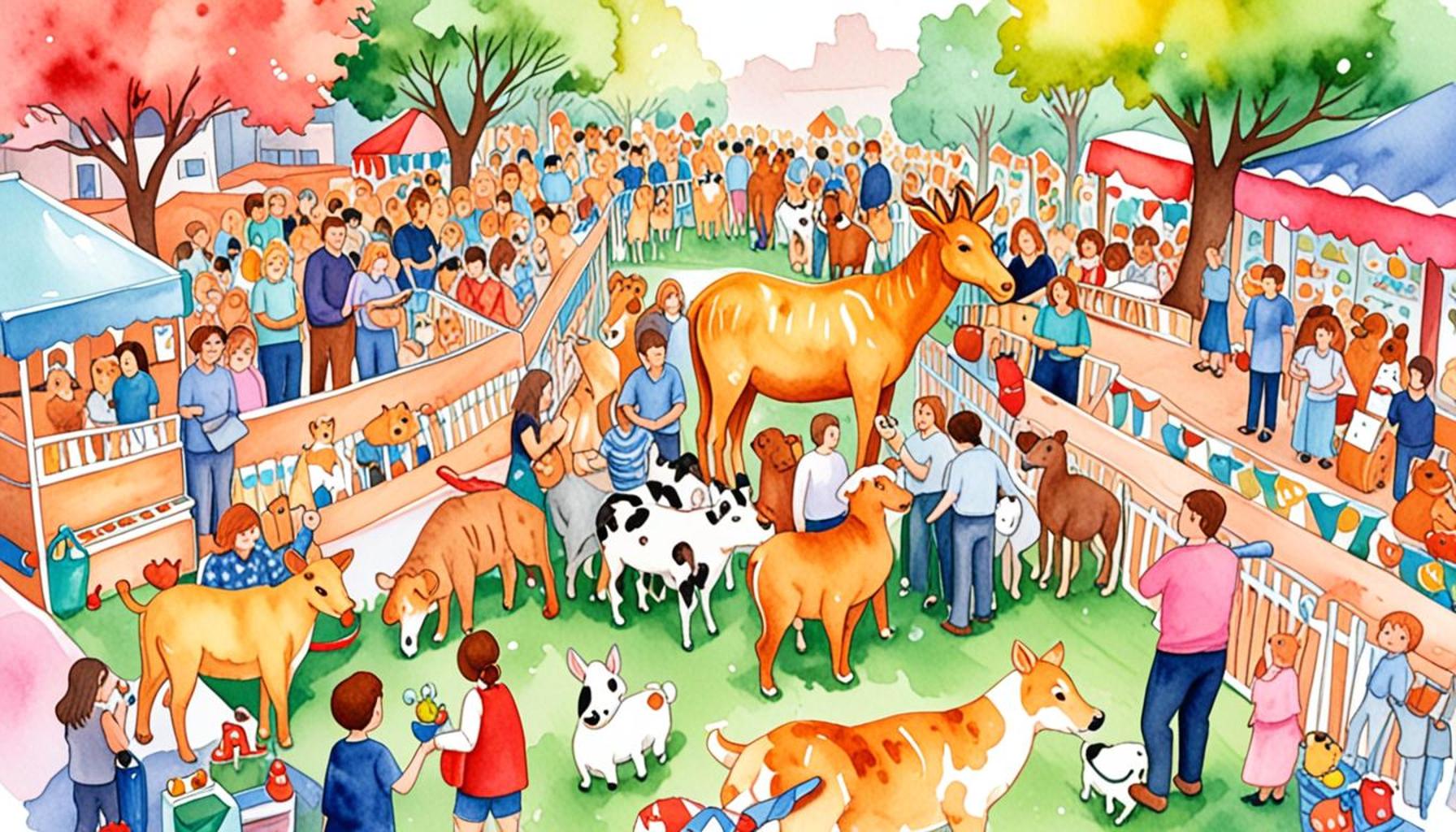How to Prepare Your Home for an Adopted Pet: Tips and Guidelines

Preparing Your Home for a New Furry Family Member
Bringing an adopted pet into your home is a rewarding experience, but it requires careful preparation. Ensuring a smooth transition for your new companion can make all the difference in their adjustment. Here are some essential tips to create a welcoming environment for your adopted pet.
- Pet-proof your space: One of the first steps in preparing your home for a new pet is to remove hazards. Common household items such as small toys, rubber bands, and even certain foods can pose choking risks. Additionally, check for toxic plants like azaleas, lilies, and oleander, which can be harmful or even fatal to pets if ingested. Pay attention to loose wires and cords that can be chewed on—consider using cord protectors to eliminate these dangers.
- Designate a safe zone: A critical part of helping your new furry friend adjust is creating a safe zone. Choose a quiet space in your home where your pet can retreat when feeling overwhelmed. Ensure this area is stocked with a cozy bed, some toys, and food and water. This sanctuary can be a crate or a separate room, allowing your pet to feel secure as they acclimate to their new surroundings. It can also help reduce anxiety during the initial days after adoption.
- Gather supplies: Invest in high-quality supplies tailored to your pet’s needs. For dogs, you’ll need food bowls, durable chew toys, and grooming tools, while cat owners should consider litter boxes and scratching posts. A reliable leash and harness are essential for taking your dog on walks, while a sturdy carrier is important for trips to the vet. Each of these items will enhance your pet’s comfort and safety in their new home.
As you prepare, it’s vital to consider your pet’s specific needs. Whether adopting a dog, cat, or another animal, understanding their behaviors and habits plays a key role in their adjustment.
- Fencing and outdoor safety: If you have a backyard, inspect your fencing thoroughly to ensure it is secure. Look for any gaps that your new pet might exploit to escape. Many rescue dogs have a strong instinct to roam, so a sturdy fence can provide them with freedom while keeping them safe. Depending on the breed, consider the height and type of fencing as some dogs are adept jumpers or diggers.
- Socialization areas: Create spaces where your pet can interact safely with family members and other pets. Allocate time for supervised interactions that help your new furry friend build confidence and learn social cues in a low-stress environment. Enrichment activities, like interactive play or training sessions, can also facilitate bonding with family members.
- Training tools: Onboarding a new pet often requires patience and skill. Plan for behavioral training to foster healthy habits and reduce anxiety. Invest in training tools such as clickers, treat pouches, and training pads, and consider enrolling in a basic obedience class. A well-socialized and trained pet will feel more secure within the family dynamic.
Adopting a pet can be life-changing, but it requires thoughtful planning. By following these tips and guidelines, you can set the stage for a happy and healthy start for your new family member. Remember, the effort you put in before bringing a furry companion home will pay off in the form of companionship, joy, and unforgettable experiences.
DON’T MISS: Click here for essential tips on preventing common pet diseases
Creating a Safe and Welcoming Environment
When preparing your home for an adopted pet, the main goal is to foster a sense of safety and comfort. This is crucial for helping your new companion adjust to their surroundings with ease. Building a suitable living environment not only enhances your pet’s quality of life but also strengthens the bond between you and your furry friend.

- Rethink furniture arrangement: Before your new pet arrives, take a moment to consider your furniture layout. Moving furniture might create more open spaces for your pet to explore and play. Ensure there are no hidden obstacles that could pose a tripping hazard. Additionally, securing any valuable or breakable items can prevent accidents and loss during your pet’s adjustment period.
- Consider vertical space: For cats, providing vertical space is equally important. Utilize cat trees or shelves that allow them to climb and perch. These structures can provide an outlet for their natural climbing instincts while offering a safe retreat to observe their surroundings. Felines thrive on height, and this can serve as an excellent way for them to feel secure in their new home.
- Stock up on essentials: Once you have set up your living areas, it’s time to focus on stocking up on essential supplies. Create a checklist for all necessary items, including:
- Food and water bowls
- Quality pet food suitable for your animal’s age and size
- Comfortable bedding or blankets
- Appropriate toys for interactive play and mental stimulation
- Grooming supplies like brushes, nail clippers, and shampoo
- Identification tags and a leash or harness, especially for dogs
Having these supplies ready to go will not only ease the transition for your new pet but will also streamline your routine once they settle in. Regular feeding schedules, access to fresh water, and engaging playtime can help build trust and companionship.
Be Mindful of Potential Dangers
As you prepare for your new pet, being aware of potential hazards around the house is essential. Pets are naturally curious, and they may explore areas that are away from their safe zones. Here are several common household items to pay attention to:
- Chemicals and cleaners: Store these substances in cabinets or on high shelves that are inaccessible to pets.
- Small objects: Items like coins, buttons, and paper clips can be choking hazards, so keep them stored safely out of reach.
- Food items: Many common foods, such as chocolate, grapes, and onions, can be toxic to pets. Ensure these and other harmful items are securely stored.
- Electrical cords: Consider using cord covers or organizing cords neatly to prevent chewing.
By taking the time to secure your living space, you are not just preventing accidents, but also showing your new companion that their safety is your top priority. A carefully arranged, hazard-free home can pave the way for a joyful and nurturing environment where your adopted pet can flourish.
Preparing Your Home for Your New Furry Friend
When adopting a pet, creating a safe and welcoming environment is critical for a seamless transition. Following a few essential tips can ensure that your home is ready for your new companion.
1. Designate a Safe Space
Before bringing your adopted pet home, determine a specific area where they will have their own space. This space should be comfortable and away from potential hazards. Consider using pet beds, toys, and blankets to create a cozy haven where your new friend can relax and feel secure.
2. Pet-Proof Your Home
Similar to child-proofing, it’s vital to pet-proof your home to avoid accidents or injuries. Secure electrical cords, remove toxic plants, and lock away cleaning supplies. Safeguarding small items like toys that could be ingested is equally important. Ensuring that your living environment is devoid of dangerous objects will help your pet feel safe exploring their new surroundings.
3. Get the Essentials
Before bringing your pet home, make a checklist of must-have supplies. Essential items include food and water bowls, high-quality pet food, leashes, toys, and grooming tools. Having these items ready will allow you to care for your new pet immediately and help you establish routines that promote their well-being.
4. Research Pet-Friendly Zones
If you live in a pet-friendly community, explore nearby parks or other areas where pets are welcomed. Familiarizing yourself with locations that allow pets can enhance your experience and improve your adopted pet’s social interactions. It’s also essential to be aware of local regulations regarding leash laws and breed restrictions.
5. Ensure Veterinary Care
Finding a trusted veterinarian should be a priority. Schedule an initial check-up to assess your pet’s health and vaccinations. Regular veterinary check-ups are vital as they help catch potential health issues early and ensure your pet stays healthy throughout their life.
6. Slowly Introduce Your Pet to the Family
If you have children or other pets, introduce your new family member gradually to minimize stress. Supervise interactions at first and allow everyone to acclimate at their own pace. Use positive reinforcement techniques to ensure a harmonious relationship among all family members.By taking these preparatory steps, you set the stage for a successful and fulfilling experience with your newly adopted pet. Embracing this journey can be incredibly rewarding for both you and your furry friend.
DISCOVER MORE: Click here for essential tips
Establishing a Routine and Transition Strategy
Preparing your home for an adopted pet extends beyond simply creating a safe environment; it also involves establishing a routine that caters to their needs and supports their transition to a new home. Pets thrive on consistency and predictability, which can help them feel more secure in unfamiliar settings.
- Set a feeding schedule: Consistency in feeding times can significantly reduce anxiety for your new companion. Choose times that fit into your daily routine, and stick to them as closely as possible. Ensure your pet has access to fresh water at all times. By establishing a regular feeding schedule, your pet will know when to expect food, contributing to their overall comfort and routine.
- Create a designated space: Select a specific area in your home for your new pet to feel secure, whether it’s a quiet corner with their bed or a cozy crate. This space should be away from hustle and bustle but accessible to you. Familiar items placed here, like blankets or toys, can help provide comfort and make this area a safe haven for your pet.
- Establish potty training routines: For dogs, introducing them to a consistent potty schedule is vital. Take your new furry friend outside first thing in the morning, after meals, and before bedtime. This not only aids in training but also reinforces the bond between you and your pet. For cats, ensure their litter box is situated in a quiet, easily accessible location, and keep it clean to encourage its use.
Overall, ensuring your pet has a consistent routine will foster a feeling of stability while aiding in the adjustment process. Additionally, a well-structured day helps owners manage their time effectively while catering to their pet’s needs.
Introducing Family Members and Other Pets
If you have children or other pets at home, it’s essential to carefully manage their introductions to your new adopted pet. This process can greatly impact your pet’s adaptation period and overall well-being.
- Prepare family members: Before bringing your new pet home, have a discussion with all household members about the responsibilities and roles they will take on. Explain to children how to interact gently and respectfully with the new pet. Even older pets need time to adjust, so discussing the importance of patience is crucial.
- Implement controlled introductions: When introducing your new pet to existing pets, do so gradually. Use baby gates or crates to allow them to observe each other from a distance initially, while they grow accustomed to each other’s presence. After a few days of observation, you can start short visits with supervision, ensuring that everyone remains calm.
- Monitor interactions: As your new pet becomes more comfortable, pay attention to their body language and behavior. Signs of stress or aggression should not be ignored. If any aggressive interactions occur, separate the animals immediately, allowing them time to decompress before trying again.
By handling introductions with care, you are laying the groundwork for a harmonious household where all pets can coexist peacefully. Gradually easing everyone into their new roles and dynamics is key to building lasting relationships.
Encouraging Play and Bonding
One of the most enjoyable aspects of welcoming a new pet into your home is the opportunity to bond through play. Interactive and stimulating activities not only foster a close relationship but also provide essential mental and physical exercise.
- Invest in quality toys: Selecting the right toys is crucial for your pet’s development. Dogs may enjoy tug toys, balls, or puzzle feeders that challenge their intellect, while cats may prefer feather wands or laser pointers. Observing your pet’s play style can help you choose toys that best cater to their instincts.
- Establish play routines: Incorporate playtime into your daily schedule. Regular interactive sessions not only alleviate boredom but also reduce behavioral issues that stem from excess energy. Aim for at least 15-30 minutes of playtime daily, depending on your pet’s species, breed, and energy level.
- Participate in training and socialization: Consider enrolling your dog in basic obedience classes or socialization groups to enhance their learning and confidence. For cats, creating a stimulating environment with interactive toys and playtime can provide mental enrichment and foster playfulness.
Engaging in fun and stimulating activities together maintains the excitement of pet ownership while promoting a strong bond built on trust and mutual enjoyment.
LEARN MORE: Click here for insights on balanced nutrition for your pet’s health
Conclusion
Welcoming an adopted pet into your home is a rewarding experience that enriches the lives of both you and your new furry friend. However, the key to a successful transition is meticulous preparation. From ensuring a safe environment to establishing a consistent routine, each action you take paves the way for a smooth integration into your home. Remember that patience is essential; new pets often need time to feel secure and acclimate to their surroundings.
As you prepare, prioritize the importance of introducing family members and existing pets. This process lays the foundation for a harmonious household, minimizing potential stressors and fostering positive relationships. Furthermore, offering engaging playtime and training opportunities not only serves to strengthen the bond between you and your adopted pet but also fulfills their mental and physical needs, encouraging well-rounded behavior.
By following these tips and guidelines, you are setting your home up to be a loving and nurturing environment. Take pride in the role you play in this beautiful journey of pet adoption, as your commitment to their well-being will ultimately create lasting memories filled with joy and companionship. If you’re eager to learn more about best practices for pet ownership or looking for additional resources to deepen your understanding, continue exploring articles and community forums dedicated to this rewarding lifestyle.


